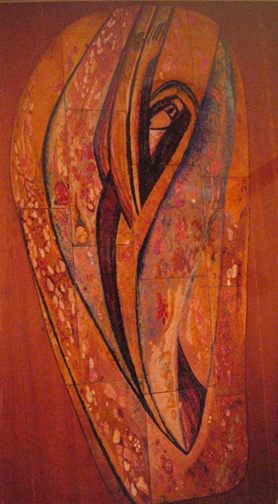 |
St.
Thérèse of Lisieux by Elisabeth Soderber-Weixelgartner Oslo, Sweden Enamel on copper This 7' by 4' multi-colored enamel painting of the Carmelite saint Thérèse of Lisieux was part of the Vatican Pavilion at the New York World's Fair in 1964-65. It was one piece in an unusual collection of distinctive enamel-on-copper works of art by Elisabeth Soderberg-Weixelgarner and her mother Pepi Weixelgartner-Neutra. It now hangs in the National Shrine of Our Lady of Mt. Carmel in Middletown, New York (USA) Other illustrations by the mother-daughter artists at the Vatican Pavilion were Three Marys at the Cross, Passion of the Lord, Way of the Cross, and other poignant religious interpretations. According to a press release at the time, "these monumental plagues are representative of the current movement of the revised liturgy in the incorporation of religious art integrally into modern church architecture. Some have been designed as altar-pieces, others for inclusion in the Parados, while others have been developed as inspirational art for display in shrines and similar areas." "Their form, color arrangement, structure, and texture are richly expressive of modern architectural forms and needs, and are excellent examples of the contemporary blending of art architecture within the modern church. Mrs. Soderberg switched to enameling after making her mark in textile and fabric designing. Her work was said to liberally use free forms with rich vivid color combinations. Her mother gained prominence through her drawings and prints which were characterized by Michelangelesque forms. Both mother and daughter made use of the great tradition set in the Renaissance Period of expressing timeless themes, especially when a religious motif is desired. They have collectively and separately exhibited their works at galleries and museums in Washington, DC (USA), New York (USA), Tokyo (Japan), Vienna (Austria), Rome (Italy), Bonn, Berlin, and Dresden (Germany), London (England), Madrid (Spain), Stockholm and Oslo (Sweden). Cuthbert Hainsworth, then a member of the PCM Province and Richard (Andrew) Champigny of the SEL Province spoke with Mrs. Soderberg when they visited her exhibit at a small art show in Rome, Italy to commemorate the fourth year of John XXIII as pope. When she found out they were Carmelites, she told them she had been asked by a pastor in Naples to design a wall piece of St. Thérèse of Lisieux for his Church. She confessed that she knew very little about St. Thérèse. They provided Mrs. Soderberg with a copy of Ida Goerres' “The Hidden Face” and other books on Thérèse. After reading these books, Mrs. Soderberg was very excited about Thérèse and showed them her first design when she visited the International House of Studies of Sant’Alberto (now CISA) in Rome. She told them that the priest in Naples thought the art piece was too “modern” for his Church. However by this time, Elizabeth was so enamored of Thérèse, that she decided to do the painting anyway. She then told Hainsworth and Champigny that she would eventually send it to the Carmelites. The artwork portraying St. Thérèse was exhibited all over Europe and then in 1964 the enamel was sent to the Vatican Pavilion at the World’s Fair in Long Island, New York, where it was exhibited for the two years of the Fair. It was then transferred to the Carmelites and brought to St. Albert's Priory in Middletown, NY. When the Province opened a house of formation dedicated to Titus Brandsma and St. Therese, in Purchase, NY the enamel art was hung in the dining room. When that house closed, it was brought back to St. Albert's Priory and the National Shrine of Our Lady of Mount Carmel.
Curator:
Richard Champigny, O. Carm. |
|
|
|